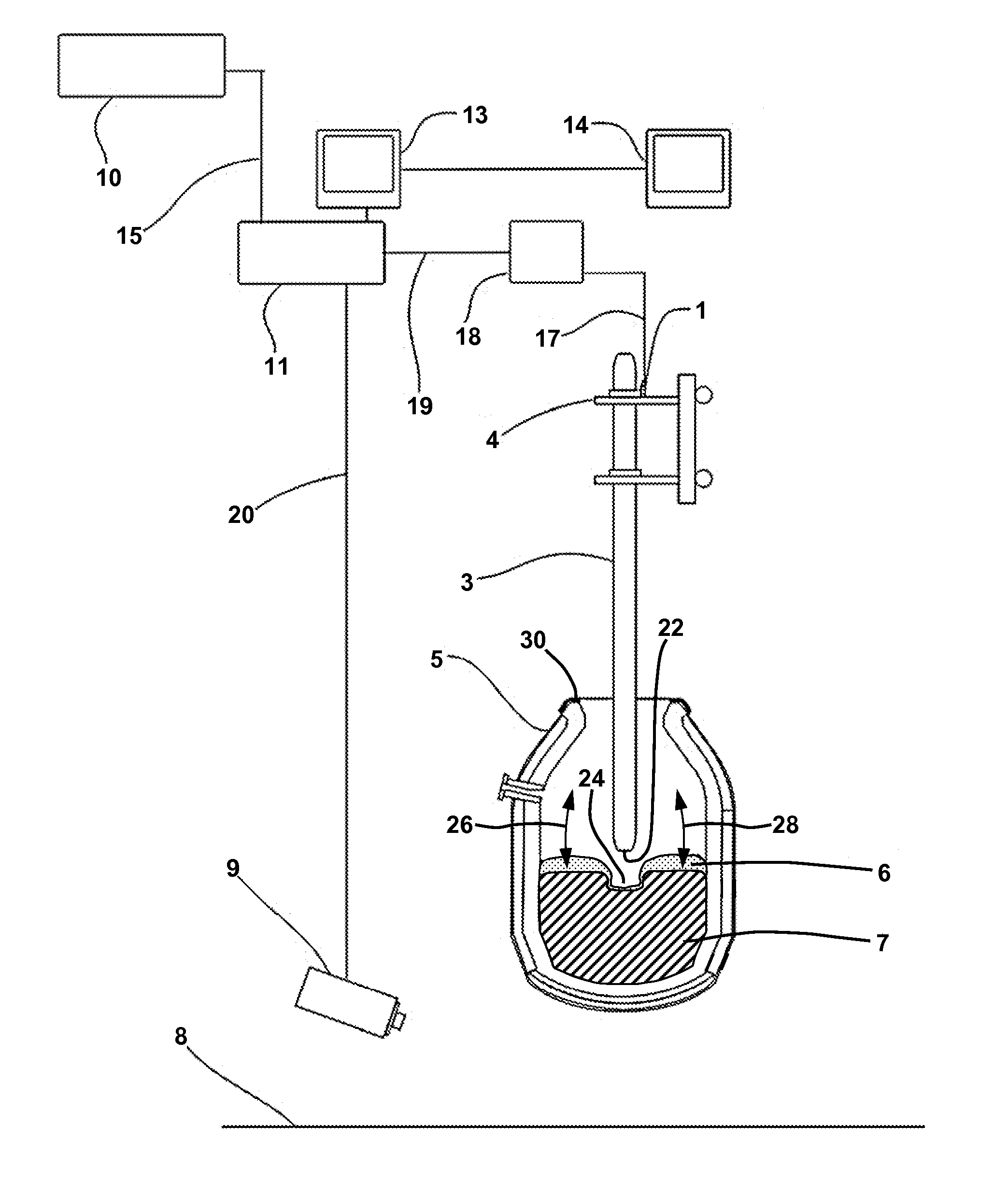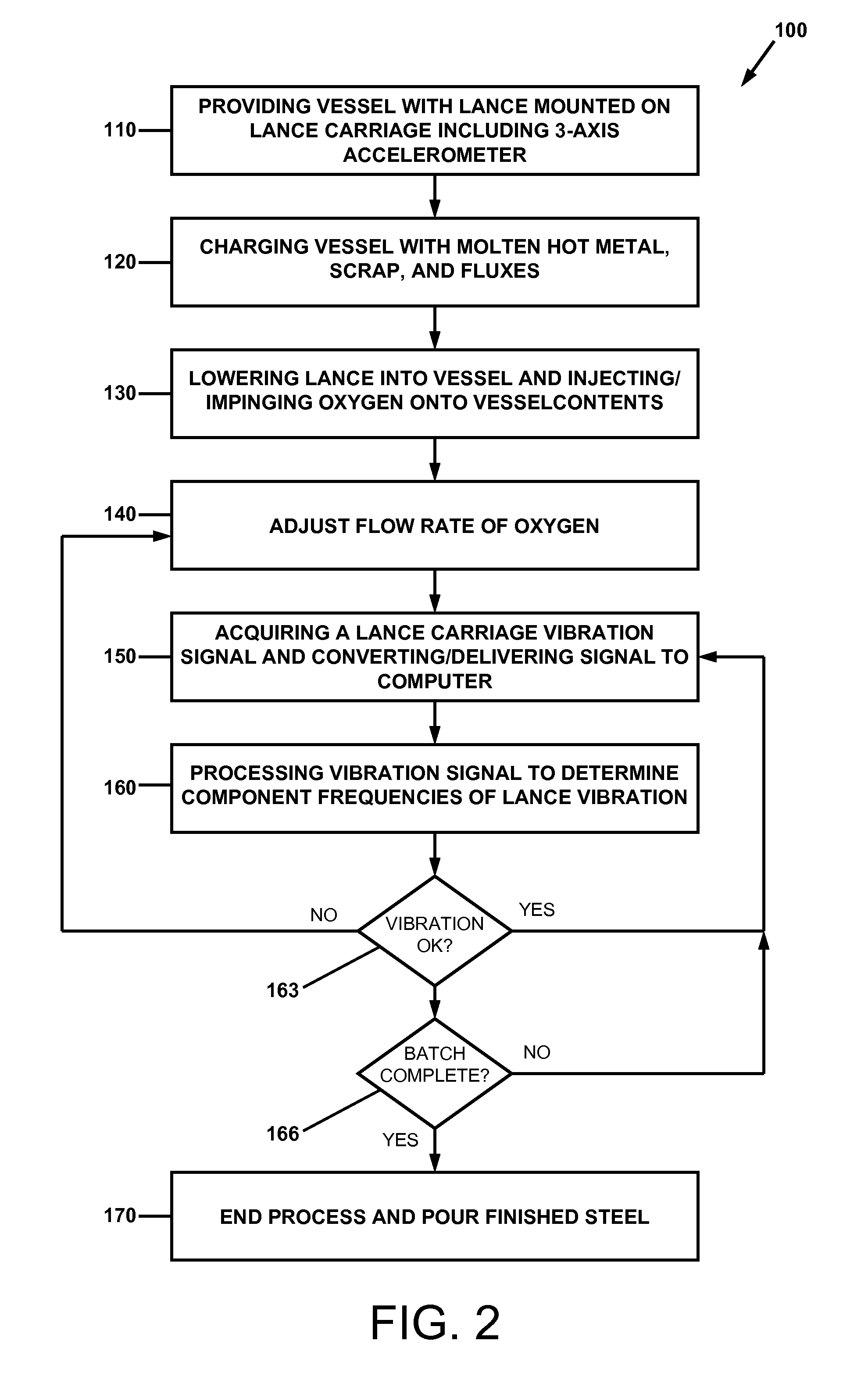System for furnace slopping prediction and lance optimization
a technology of system and lance, applied in the direction of furnaces, manufacturing converters, lighting and heating apparatus, etc., can solve the problems of ejection of molten steel and slag therefrom, cost and time consumption, yield loss and cost, etc., and achieve the effect of reducing the requirement for re-blow
- Summary
- Abstract
- Description
- Claims
- Application Information
AI Technical Summary
Benefits of technology
Problems solved by technology
Method used
Image
Examples
example 1
Lance Oxygen Flow Rate Optimization
[0049]A BOF vessel 5 was charged with molten hot metal, scrap and fluxes. After charging the furnace 5, the furnace 5 was rotated to the vertical position and a lance 3 was lowered into the vessel 5. Oxygen was injected through the lance 3 and its force of impingement as it exited the lance ports at tip 22 formed a cavity 24 on the surface of the charge 6 / 7. As oxygen was injected during the process, the removal of carbon and the formation of a liquid slag 6 proceeded.
[0050]A three-axis integrated circuit piezoelectric accelerometer 1 was mounted on the lance carriage 4 to monitor the lance carriage vibration resulting from oxygen flow through the lance 3 and from other process variables. The vibrations were converted to an analog electrical signal that was digitized using a data acquisition system 18 and computer 11.
[0051]The digital signal was processed using a Fourier Transform to determine the component frequencies. Vibration amplitude in the f...
example 2
Incipient Slopping Prediction
[0056]A BOF vessel 5 was charged with molten hot metal, scrap and fluxes. After charging the furnace 5, the furnace 5 was rotated to the vertical position and a lance 3 was lowered into the vessel 5. Oxygen was injected through the lance 3 and its force of impingement as it exited the lance ports formed a cavity 24 on the surface of the charge 6 / 7. As oxygen was injected during the process, the removal of carbon and the formation of a liquid slag 6 proceeded.
[0057]A three-axis integrated circuit piezoelectric accelerometer 1 was mounted on the lance carriage 4 to monitor the lance carriage vibration resulting from oxygen flow through the lance 3 and from other process variables. The vibrations were converted to an analog electrical signal that was digitized using a data acquisition system 18 and computer 11.
[0058]The digital signal was processed using a Fourier Transform to determine the component frequencies. Vibration amplitude in the frequency range o...
example 3
Slopping Detection
[0060]A BOF vessel 5 was charged with molten hot metal, scrap and fluxes. After charging the furnace 5, the furnace 5 was rotated to the vertical position and a lance 3 was lowered into the vessel 5. Oxygen was injected through the lance 3 and its force of impingement as it exited the lance ports formed a cavity 24 on the surface of the charge 6 / 7. As oxygen was injected during the process, the removal of carbon and the formation of a liquid slag 6 proceeded.
[0061]A three-axis integrated circuit piezoelectric accelerometer 1 was mounted on the lance carriage 4 to monitor the lance carriage vibration resulting from oxygen flow through the lance 3 and from other process variables. The vibrations were converted to an analog electrical signal that was digitized using a data acquisition system 18 and computer 11.
[0062]The digital signal was processed using a Fourier Transform to determine the component frequencies. Vibration amplitude in the frequency range of 4-500 Hz ...
PUM
| Property | Measurement | Unit |
|---|---|---|
| Flow rate | aaaaa | aaaaa |
| Content | aaaaa | aaaaa |
| Level | aaaaa | aaaaa |
Abstract
Description
Claims
Application Information
 Login to View More
Login to View More - R&D
- Intellectual Property
- Life Sciences
- Materials
- Tech Scout
- Unparalleled Data Quality
- Higher Quality Content
- 60% Fewer Hallucinations
Browse by: Latest US Patents, China's latest patents, Technical Efficacy Thesaurus, Application Domain, Technology Topic, Popular Technical Reports.
© 2025 PatSnap. All rights reserved.Legal|Privacy policy|Modern Slavery Act Transparency Statement|Sitemap|About US| Contact US: help@patsnap.com



